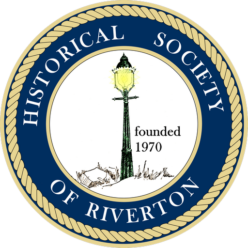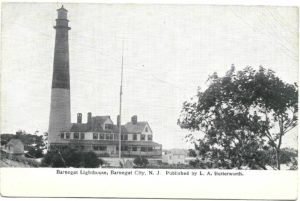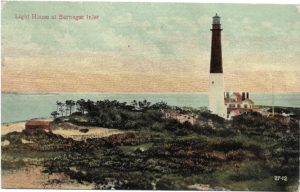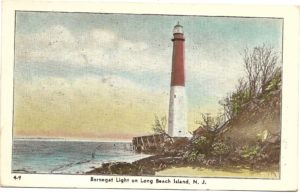
Old Barney: The Light That Never Fails
by Harlan B. Radford, Jr.

Affectionately called “Old Barney” and one of New Jersey’s best-known landmarks, the iconic lighthouse known as Barnegat Light is located on the northern tip of Long Beach Island and on the south shore of Barnegat Inlet. Mariners considered the Barnegat Lighthouse one of the most important “change of course” points for coastal vessels bound to and from New York along the New Jersey coast.
Its essential purpose was to warn ships away from the treacherous and shifting shoals which extended out from the shore. This particular area was very dangerous as ship captains had to contend with not only the shifting sandbars but with mighty currents as well.

Numerous illustrations and picture postcards both old and new will provide some historical background about the famous Barnegat Lighthouse.
What makes Old Barney so distinctive and recognizable as a navigational landmark is her colorization or her “daymark” features – that is to say the lighthouse has a red upper half and a white lower half. Barnegat Light as we know it has remarkably endured and served for 160 years!
Author Glenn D. Koch in his informative 2007 coffee-table book entitled “Picturing Long Beach Island” makes a good case for calling the Barnegat Lighthouse an iconic symbol that has become synonymous with Long Beach Island. Koch elaborates:
Her familiar red and white pattern of paint is immediately recognizable to anyone who has ever seen it. Her iconographic image has appeared on everything from bank checks to calendars to milk bottles and continues to appear on thousands of other souvenirs year after year. Since the earliest days of the postcard, publishers have been capturing and producing her image.
In 1834, Barnegat Light became the fourth sentinel on the New Jersey coast. Only 40 feet tall and with a very limited and dim beacon, this tower would soon prove itself to be wholly inadequate as the shipwrecks and groundings in that vicinity continued.
The passage of just two decades brought forth plans for the construction of a new and higher first-class lighthouse tower in 1856 with a considerably more powerful first-order lamp. Half-way through the construction of this new light, the original structure succumbed to the continual onslaught of the ocean. The replacement, which endures today, stands 170 feet tall and is situated some 900 feet from shore.
The only way to reach the top is by ascending 217 steps on a winding staircase. West Point graduate George Gordon Meade who later led Union troops during the Battle of Gettysburg during the American Civil War hero engineered and supervised its construction.

The completion and official opening of this replacement lighthouse occurred on January 1, 1859. Its twin walls of brick, range 27 feet in diameter at the base to less than 15 feet at the top. A glass lantern house topped the tower. Interestingly, the original light assembly, known by some as “Old Barney’s Eye,” was eventually removed and now resides in the Barnegat Light Historical Society Museum located at 501 Central Ave, Barnegat Light, N.J.
Henri Lepaute of Paris fabricated that light assembly from glass made at the famous French Furnace at St. Gobian. It consists of 1,024 separate prisms mounted in bronze fittings forming a lens eight feet in diameter and fifteen feet high. Delicately balanced on heavy bronze rollers, the five-ton light could be rotated simply by the pressure of one’s little finger.
The original lamps were kerosene and consisted of five wicks of one, two, three, four, and five-inch diameters all placed within the other. The reservoir for the lamps held ten gallons of oil, consuming four and a half gallons a night in the summer and as much as seven and a half gallons a night in the winter. This fuel had to be carried daily by hand all the way up the spiral staircase to the light at the top.
Rotation of the light was accomplished by a 150-pound weight that was hung on a 65-foot steel cable and the entire mechanism operated much like the weights found in a typical grandfather clock. Is was said that Barnegat’s light had to be wound once every hour and that the lense revolved once every four minutes giving 24 distinct flashes, each lasting two seconds. The so-called “light characteristic” of Barnegat Light was determined to be a flash every ten seconds at each point of the compass and it had a range of twenty nautical miles.
A few years after the tower was finished, a two-story wick-house was added. Then in 1889, a large cottage for the lighthouse keepers and their families was completed. This 20-room, two-and-one-half story building consisted of three Victorian cottages that accommodated the keeper and his two assistants, who not only maintained the light but tended to the surrounding grounds.
Typically the lighthouse watch was divided into three daily shifts which occurred from sunset to 10PM, 10PM to 2AM, and 2AM to sunrise. Once a lighthouse keeper came on duty, he could not leave. It would take three men – a keeper and two able assistants to maintain the lighthouse each shift. It was vital that the lightkeeper kept the light turning and operational at all times.

Unfortunately, it would not be long before the relentless pounding of the ocean, tides, and storms undermined the keeper’s house and by 1920 the remains were torn down.
The known lighthouse keepers in sequence to 1936 were as follows: 1. James Fuller, 2. Burch Brown, 3. Jack Kelley, 4. Joshua Reeves, 5.) Thomas Bills, 6. William Woodmansee, 7. Clarence H. Cranmer, 8. Andrew E. Applegate, 9. Robert E. Applegate and 10. William E. Rothes.
Over the years that have followed, men constantly struggled with nature and battled the inevitable erosion and storms. They undertook the construction of a number of rock jetties to try and slow the loss of land close to the inlet.
Beginning in 1943, during the construction of one such north jetty, two massive steel towers were built with cables strung across the entire Barnegat Inlet with one tower near the lighthouse on Long Beach Island and the other tower located on the other side of the inlet on the southern tip of what is known as Island Beach. One by one, on slings across the inlet, large granite boulders were carried by way of the strong elevated cables across the inlet and placed on railroad flatcars and taken by rail for placement by a crane to create the jetty. This huge undertaking took a couple of years to complete and was essential to preserving the integrity of the land area around the lighthouse itself.

By 1927 Barnegat Lighthouse was decommissioned, the beacon went dark and the entire property was turned over to the state of New Jersey. From that point on to 1965, Barganet Light was replaced as a beacon by a lightship bearing the same name “Barnegat” that was manned by a crew of fourteen and anchored eight miles off-shore.
This new type of lightship was twin-masted and its role was to warn commercial ships of shallow water and shoals. Atop each of the masts were three oil-fed lanterns. In addition to a bright light at 8-second intervals, the ship was capable of emitting a loud steam-chime whistle every 20 seconds and during foggy conditions, there was a fog horn capable of being heard a distance of four miles. Over time, this lightship method became obsolete and after 38 years it was removed and replaced with radar and electronic means of navigation.


For a while during the Second World War, the U. S. Coast Guard used Old Barney as a look-out station to keep watch for German submarines off the Jersey coast.
When world peace was restored the lighthouse was taken out of service and the site reverted back to control by New Jersey. In 1951, Barnegat Light was designated as a State Park and by 1957, the park was formally dedicated and a monument consisting of a plaque, and a bust of General George Meade was unveiled at the base of the light overlooking the ocean.

In 1988, Barnegat Light closed for renovations and needed repairs. Work concluded three years later and Barnegat Light re-opened once more for visitors. After some 150 years, the famous landmark sported a new automated light on January 1, 2009, and thanks to preservationists was ceremonially re-lit to the delight of many.

In order to satisfy Coast Guard specifications, this new light had to be an actual aid to navigation and not just a mere beacon. Happily, the current apparatus, a 100-watt, 42-pound VRB-25 light, imported from New Zealand satisfies and meets all Coast Guard requirements. Long may Old Barney’s light continue to beam brightly into the future.
 This author recalls times as a young child when in the late 1940s my father photographed me standing at the base or even atop Barnegat Lighthouse while on summer vacation to Harvey Cedars.
This author recalls times as a young child when in the late 1940s my father photographed me standing at the base or even atop Barnegat Lighthouse while on summer vacation to Harvey Cedars.
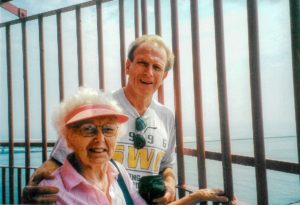
Many years later, my mother and I ventured back down to the Jersey Shore and Long Beach Island and re-lived some distant memories at our favorite lighthouse. It was still possible then for my mother to climb those 217 steps to the very top with me and we marked our celebratory moment with a photo.
Sending postcards began as a fad in the final years of the nineteenth century as travel happy Americans began scribbling their sentiments on thin, three-and-a-half-by-five-and-a-quarter-inc
h pieces of cardboard whose front sides were printed with a local view. In 1908 the United States Post Office Department delivered a staggering 667,777,798 postcards.” The little cards solved a lot of communications problems especially for those of few words or for those who didn’t like writing letters.”
It is not surprising that so many personally penned messages appeared on postcards over the years with the brief phrase “Wish you were here!” What memories do you have of Barnegat Lighthouse?
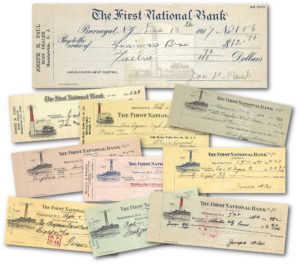
A.) The First National Bank of Barnegat, New Jersey issued 10 different variations of bank checks depicting Barnegat Light over the span of years from 1917 to 1944.
B.) New Jersey Division of Motor Vehicles “Shore To Please” License Plate
 C.) Local Beach Haven merchant C. T. Whalon electrical and appliance contractors made a 1949 historic Barnegat Lighthouse Calendar.
C.) Local Beach Haven merchant C. T. Whalon electrical and appliance contractors made a 1949 historic Barnegat Lighthouse Calendar.
 D.) ESSO Standard Oil Company distributed this 1951 New Jersey Road Map with Pictorial Guide free of charge. As they said, “Happy Motoring”.
D.) ESSO Standard Oil Company distributed this 1951 New Jersey Road Map with Pictorial Guide free of charge. As they said, “Happy Motoring”.
E.) Artist Bill Kane sketched and printed a set of postcards circa 1950 consisting of 10 different sketches highlighting Barnegat Lighthouse and promoting the theme “Visit Magic Long Beach Island – Six Miles at Sea. Vacation’s Playland on the Jersey Coast.”
F.) Large letter postcard and map postcards each display the Barnegat Lighthouse.
G.)  Sponsored by the Ocean County Stamp Club and bearing two postmarks dated FEB. 15, 1950 from both Toms River and Barnegat Light, this postcard displays a colorful red and blue printed cachet commemorating the 1850-1950 Centennial of Ocean County.
Sponsored by the Ocean County Stamp Club and bearing two postmarks dated FEB. 15, 1950 from both Toms River and Barnegat Light, this postcard displays a colorful red and blue printed cachet commemorating the 1850-1950 Centennial of Ocean County.
 H.) A special message overprinted in red ink announces the “100th Birthday of Historic Barnegat Light”. Referred to as “America’s Grand Old Champion of the Tides.”
H.) A special message overprinted in red ink announces the “100th Birthday of Historic Barnegat Light”. Referred to as “America’s Grand Old Champion of the Tides.”
I.) Souvenir Folders consisted of a fold-out grouping of a dozen or so postcard images all in one mailer. This one features 12 different views of Barnegat Lighthouse.
 Such souvenir folders typically include information about the towns of Long Beach Island and promote LBI as “The Home of Happy, Healthy Sand, Sea and Sunshine” with 18 miles of sandy white beaches.
Such souvenir folders typically include information about the towns of Long Beach Island and promote LBI as “The Home of Happy, Healthy Sand, Sea and Sunshine” with 18 miles of sandy white beaches.
 J.) Creased in the center and designed to be folded over when addressed, this postcard bears a green 1-cent Ben Franklin postage stamp and AUG. 9, 1907 postmark.
J.) Creased in the center and designed to be folded over when addressed, this postcard bears a green 1-cent Ben Franklin postage stamp and AUG. 9, 1907 postmark.
K.) Ten oversized, or jumbo, postcards measuring as much as 6-1/2 X 9 inches featuring Barnegat Lighthouse
L.) 17 professional color photographs courtesy of Studio 9 Photo Center, Route 9, Waretown Plaza, Waretown, NJ 08758.
M.) Note the evolution of postcard production from older postcards with white-borders to the linens to the more modern era of photochromes in this chronological sequence of postcards from 1906-1966.
Search “Barnegat Light” on YouTube and one gets dozens of results. This is one of the professionally produced productions.
Here’s another from NBC 10.
Nicely done drone footage video.
Can you recommend a good Barnegat Light video? We welcome your comments and questions.
